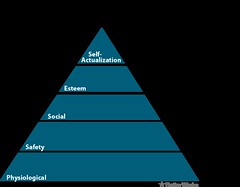![]()
![]()
![]()
Use LEFT and RIGHT arrow keys to navigate between flashcards;
Use UP and DOWN arrow keys to flip the card;
H to show hint;
A reads text to speech;
23 Cards in this Set
- Front
- Back
|
Learning Styles |
Visual Learners- learn by watching and imitating. -Demonstrate and use videos Auditory/Cognitive- Verbalize and understand skiing -give descriptions with words -be precise, give rationale Kinesthetic/Proprioceptive- feel the skiing -allow them to feel the skiing |
|
|
Guest Centered Teaching |
Motivational Needs- what is the motivation of skiing Understanding Needs- guest awareness of ability/inability Movement Needs- through MA, determine what the single most important movement needs are for student |
|
|
Command Style Teaching |
teacher controls all actions, teacher is center of attention. Gives feedback for right vs wrong |
|
|
Task Style teaching |
Teacher outlines parameters of task. explains and demonstrates task and makes guidelines. students execute within given boundaries. Teacher gives feedback and alters task based upon needs |
|
|
Reciprocal Style Teaching |
pairs or groups established "doers and waters" are defined. Task is explained and demonstrated and evaluation criteria is outlined. Students perform and evaluate each other doing it. Teacher can give feedback. |
|
|
Guided Discover Style Teaching |
series of questions or experiences to guide student to specific answer. Each step builds on the last. Teacher leads group to discover specific outcome. |
|
|
Problem Solving |
problem posed to students. teacher sets framework, time limits, and work area for finding answer. work independently or as a team, students find answer. may be more than 1 answer. |
|
|
Maslow's Heirarchy of Needs |

|
|
|
Howard Gardner's Multiple Intelligences |
Verbal Linguistic-words, language, reading, talking Logical Mathematical-why and how, patterns, logical steps, works to solve problems = # smart Spatial- adept at manipulating shapes and objects, . like drawing, design, puzzles, (picture smart) Bodily Kinesthetic- mover, toucher, feeler, (body smart) Musical Rhythmic- sounds, rhythm, (music smart) Interpersonal- Social, emotions, negotiator and leader Intrapersonal- solitude, aware of self, sets personal goals Naturalistic- loves the outdoors and nature |
|
|
Jenson's Learning Process |
Readiness: circumstances surrounding learning situation, physical, environmental, social, emotional Reception: preferred sensory input mode for indv learner (visual, auditory) Processing: method of digesting and absorbing info (brain hemisphere dominance etc) Reaction: what the individual does with the info |
|
|
Kolb |
Perception- way that the person views world and collects info. -big picture/feeler -parts/thinker Processing- Way person mentally manipulated the info -active experimenters:doers -reflective observers: watchers |
|
|
McCarthy 4 Types of Learners |
Type 1 Innovative Learners Type 2 Analytical Learners Type 3 Active Learners Type 4 Dynamic Learners |
|
|
Innovative Learners- |
see the whole first, then parts. - sensitive, creative, learn in discussions. emphasis on making sense of word "why" |
|
|
Analytical Learners |
Quiet observers, perceive details first then develop understanding of the whole. - studious, organized, detailed, accurate, patient "What?" |
|
|
Active Experimenters |
Perceives details to the whole but learn best when actively engaged in manipulating and using concept in the environment. very pragmatic and practical, problem solvers. Favorite q is "how" things work and how they can be solved. |
|
|
Dynamic Learners |
sensory. proceed from whole to parts and need to be actively engaged in learning situations "people persons" what if idea. Jump in and try gut solutions. "What if?" |
|
|
Piaget's Stages of Development |
Sensory-motor- birth-age 2 -explore world through sensory stimuli "hunger" Pre-Operations- age 2-6 -understanding based on prior experience or sensory -unable to manipulate objects in space mentally -think in terms of what is Concrete Operations- age 6-10 -thinking mostly based on concrete objecst, but beginning to visualize and manipulate objects mentally. -can imagine "what if Formal Operations- age 10+ -abstract thinking is beginning to develop. concepts or ideals such as "fairness" and "responsibility" have meaning |
|
|
Blooms Stages of Learning |
Knowledge- remember Comprehension-understand Application-use Analysis-break out parts Synthesis- discover new applicants Evaluation- determine value |
|
|
Jung and Meyers Briggs |
Focus of Attention: -Extrovert vs Introvert How do you learn? - sensing (facts data) -intuitive (possibilities, (overall patterns) How do you Decide? - thinking- logic and objective standard -feeling- values and inner harmony How do you orient to outer world? - Judging- structured, organized, decisive -Perceiving- flexible, spontaneous, adaptive |
|
|
CAP Model |
Cognitive (thinking), Affective(feeling), Physical |
|
|
Teaching Styles |
Command Task Reciprocal Guided Discovery Problem Solving |
|
|
Movement Analysis |
1. Observation and descripiton -student profile and description observe, mechanics 2. Cause and Effect Relationship - look for cause, specify where in turn problem occurs, 3. Prescription for Change - target cause that needs to be changed activity that ecompasses 4. Lesson Plan - create plan from students needs relevant goal and skill. pace for comprehension, loop through goals stage if expectations not forthcoming |
|
|
MA Lesson Plan |
student profile, description of mechanics, cause and effect, prioritize lesson plan |

